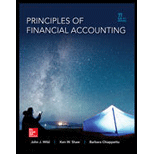
Concept explainers
1.
Calculate (a) the value of equity on December 31, 2014 (b) value of equity on December 31, 2015 (c) value of liabilities on December 31, 2015 for Company A.
1.
Explanation of Solution
Liabilities:
Liabilities are an obligation of the business to pay to the creditors in future for the goods and services purchased on account or any for other financial benefit received. It can be current liabilities or a non-current liabilities depending upon the time period in which it is paid.
(a)
Calculate the value of equity on December 31, 2014.
Therefore, the value of equity as on December 31, 2014 is $30,500.
(b)
Calculate the value of equity on December 31, 2015.
Therefore, the value of equity as on December 31, 2015 is $41,500.
(c)
Calculate the value of liabilities on December 31, 2015.
Therefore, the value of liabilities as on December 31, 2015 is $16,500.
2.
Calculate (a) the value of equity on December 31, 2014 (b) value of equity on December 31, 2015 (c) value of net income for the year 2015 for Company B.
2.
Explanation of Solution
(a)
Calculate the value of equity on December 31, 2014.
Therefore, the value of equity as on December 31, 2014 is $12,500.
(b)
Calculate the value of equity on December 31, 2015.
Therefore, the value of equity as on December 31, 2015 is $13,500.
(c)
Calculate the value of net income for the year 2015 for Company B.
Therefore, net income of Company B reported an amount of $1,600 during the year 2015.
3.
Calculate the value of assets on December 31, 2015 for Company C.
3.
Explanation of Solution
Calculate the value of assets on December 31, 2015 for Company C.
Therefore, the value of assets as on December 31, 2015 is $55,875.
Working notes:
Calculate the value of equity on December 31, 2014 of Company C.
Calculate the ending balance of equity of Company C.
4.
Calculate the value of stock issuance during the year 2015 for Company D.
4.
Explanation of Solution
Calculate the value of stock issuance of Company D for the year 2015.
Therefore, stock issuance of Company D reported an amount of $27,000 during the year 2015.
Working notes:
Calculate the value of equity on December 31, 2014 of Company D.
Calculate the ending balance of equity of Company D.
5.
Calculate the value of liabilities for December 31, 2014 for Company E.
5.
Explanation of Solution
Calculate the value of liabilities of Company E for December 31, 2014.
Therefore, the value of liabilities as on December 31, 2014 is $91,500.
Working notes:
Calculate the value of equity on December 31, 2015.
Calculate the ending balance of equity.
Want to see more full solutions like this?
Chapter 1 Solutions
Principles of Financial Accounting.
- Please provide the correct answer to this general accounting problem using valid calculations.arrow_forwardPlease help me solve this general accounting question using the right accounting principles.arrow_forwardCan you help me solve this general accounting problem using the correct accounting process?arrow_forward

 AccountingAccountingISBN:9781337272094Author:WARREN, Carl S., Reeve, James M., Duchac, Jonathan E.Publisher:Cengage Learning,
AccountingAccountingISBN:9781337272094Author:WARREN, Carl S., Reeve, James M., Duchac, Jonathan E.Publisher:Cengage Learning, Accounting Information SystemsAccountingISBN:9781337619202Author:Hall, James A.Publisher:Cengage Learning,
Accounting Information SystemsAccountingISBN:9781337619202Author:Hall, James A.Publisher:Cengage Learning, Horngren's Cost Accounting: A Managerial Emphasis...AccountingISBN:9780134475585Author:Srikant M. Datar, Madhav V. RajanPublisher:PEARSON
Horngren's Cost Accounting: A Managerial Emphasis...AccountingISBN:9780134475585Author:Srikant M. Datar, Madhav V. RajanPublisher:PEARSON Intermediate AccountingAccountingISBN:9781259722660Author:J. David Spiceland, Mark W. Nelson, Wayne M ThomasPublisher:McGraw-Hill Education
Intermediate AccountingAccountingISBN:9781259722660Author:J. David Spiceland, Mark W. Nelson, Wayne M ThomasPublisher:McGraw-Hill Education Financial and Managerial AccountingAccountingISBN:9781259726705Author:John J Wild, Ken W. Shaw, Barbara Chiappetta Fundamental Accounting PrinciplesPublisher:McGraw-Hill Education
Financial and Managerial AccountingAccountingISBN:9781259726705Author:John J Wild, Ken W. Shaw, Barbara Chiappetta Fundamental Accounting PrinciplesPublisher:McGraw-Hill Education





